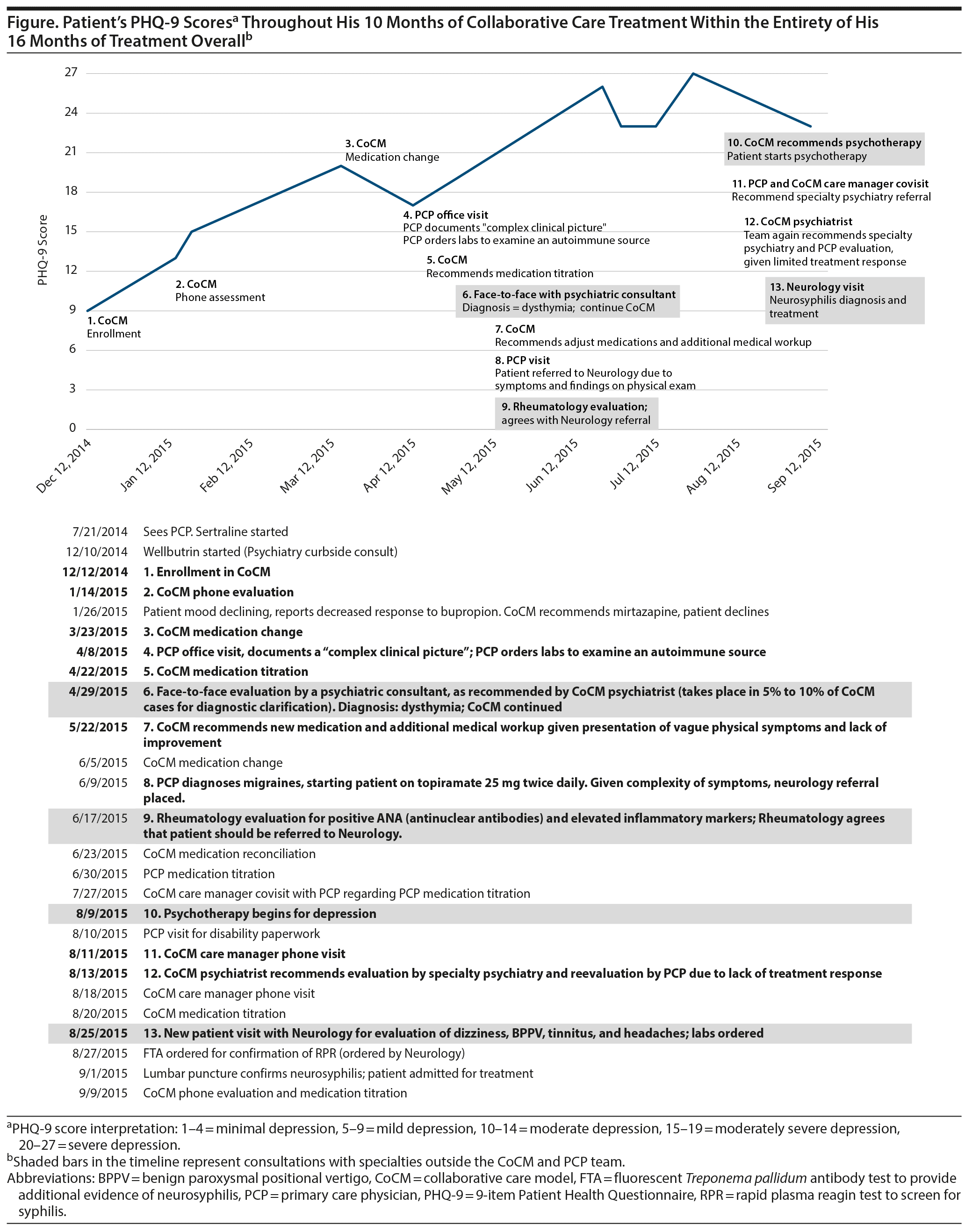
Diagnosis of Neurosyphilis in a Collaborative Care Setting
Mood and anxiety disorders often present in primary care settings as somatic disorders, and, likewise, somatic disorders can present as anxiety or depression. Primary care providers (PCPs) face competing demands in a fast-paced environment, requiring diagnostic skills and minimization of unnecessary testing, thus making discernment between mood and somatic disorders challenging. We present a case of neurosyphilis identified in a primary care clinic, demonstrating that longitudinal assessment and teamwork within the collaborative care model (CoCM) are essential for proper diagnosis.
Case Report
Mr A is a 57-year-old white man seen in a primary care clinic employing the IMPACT (Improving Mood—Promoting Access to Collaborative Treatment) CoCM model.1 His psychiatric history includes major depressive disorder and alcohol use disorder in sustained remission. His medical history includes diabetes mellitus, hyperlipidemia, and benign paroxysmal positional vertigo. Mr A presents with multiple somatic complaints and depression symptoms and thus is referred to the CoCM program for structured diagnostic assessment and review by the care manager with the psychiatric consultant. The psychiatrist feels the initial medical workup is sufficient to rule out any common, nonpsychiatric pathology-causing mood symptoms.
Mr A completes several psychotropic medication trials; dosing, adherence, and time on medication are all appropriate for effective treatment of depression. The care manager engages him in behavioral interventions (Figure 1).
Despite medication and intensive care management, 9-item Patient Health Questionnaire2 and 7-item Generalized Anxiety Disorders scale3 scores persist in the severe range, prompting the CoCM team to recommend the PCP to reevaluate Mr A for a secondary cause of his treatment-resistant depression.
The PCP finds that Mr A has worsening neurologic symptoms (word-finding difficulties, subtle fast-beating nystagmus, positive Dix-Hallpike test, difficulty with tandem walking, wide-based gait, and weakness in hip and neck flexion), prompting neurology referral and brain magnetic resonance imaging (MRI). MRI demonstrates scattered, nonspecific, patchy white matter changes thought to relate to chronic microangiopathy disease or migraines. Neurology orders laboratory testing, which reveals a positive RPR (rapid plasma reagin) and FTA-ABS (fluorescent Treponema pallidum antibody-absorption). Cerebrospinal fluid (CSF) demonstrates a reactive CSF FTA-ABS and CSF VDRL (Venereal Disease Research Laboratory), indicating neurosyphilis.
Mr A receives penicillin G. He demonstrates mild improvement in dizziness and resolution of neurosyphilis, though he has ongoing mood difficulties. Throughout this treatment, the team monitors his mood, titrates medication, and engages him in behavioral interventions. He reports relief at the diagnosis and treatment of the neurosyphilis as well as motivation to continue engagement in mental health care to manage his mood.
Discussion
Treatment of patients via CoCM allows for quick access to behavioral health care.1 Some patients in this model fail to improve throughout the course of treatment. The care management component of CoCM allows for identification of these patients and potentially earlier identification of patients who need a further medical workup by their PCP. In this case, the collaborative care team recognized a patient who was not improving and referred him back to the PCP, and the PCP’s relationship with the patient, physical examination, and diagnostic workup identified neurosyphilis.
Conclusion
PCPs face time restrictions when treating mental health disorders, often encountering treatment adherence issues and lack of patient follow-up. These factors make it quite challenging for PCPs to discern between primary and secondary mood disorders.4 Collaborative care teams are uniquely positioned to identify patients not responding to treatment, in contrast to usual-care patients who are at risk of being lost to follow-up. PCPs are likewise uniquely positioned to perform a medical workup for their patients who are not responding, thus demonstrating the power of the CoCM partnership. Psychiatric consultants should always think broadly about the need to recommend more extensive medical evaluation by the PCP in certain patient populations that do not clinically improve with evidence-based care such as CoCM, as somatic disorders may be masquerading as more straightforward mood, anxiety, or substance use disorders.
Published online: August 1, 2019.
Potential conflicts of interest: None.
Funding/support: This project is supported by funds from The Centers for Medicare and Medicaid Services through the Michigan Department of Health and Human Services, as well as the Washtenaw Health Initiative (University of Michigan, St. Joseph Mercy Health System, Washtenaw Health Plan), Blue Cross Blue Shield of Michigan Foundation, Michigan Department of Community Health Innovation Grant, and the Flinn Foundation.
Role of the sponsor: The sponsor had no role in the design and conduct of the study.
Patient consent: Dr Warnick contacted the patient via telephone and explained the case report. The patient verbally consented. There are no identifiable patient characteristics in the report.
REFERENCES
1. Archer J, Bower P, Gilbody S, et al. Collaborative care for depression and anxiety problems. Cochrane Database Syst Rev. 2012;10:CD006525. PubMed CrossRef
2. Kroenke K, Spitzer RL, Williams JBW. The PHQ-9: validity of a brief depression severity measure. J Gen Intern Med. 2001;16(9):606-613. PubMed CrossRef
3. Spitzer RL, Kroenke K, Williams JB, et al. A brief measure for assessing generalized anxiety disorder: the GAD-7. Arch Intern Med. 2006;166(10):1092-1097. PubMed Cro
4. Cosci F, Fava GA, Sonino N. Mood and anxiety disorders as early manifestations of medical illness: a systematic review. Psychother Psychosom. 2015;84(1):22-29. PubMed CrossRef
aDepartment of Psychiatry, University of Michigan, Ann Arbor, Michigan
bDepartment of Family Medicine, University of Michigan, Ann Arbor, Michigan
*Corresponding author: Stephen Warnick, MD, Department of Family Medicine, University of Michigan, 300 North Ingalls St, NI4C06, Ann Arbor, MI 48109-5435 ([email protected]).
Prim Care Companion CNS Disord 2019;21(4):18l02399
To cite: LePlatte D, Marasco S, Warnick S, et al. Diagnosis of neurosyphilis in a collaborative care setting. Prim Care Companion CNS Disord. 2019;21(4):18l02399.
To share: 10.4088/PCC.18l02399
© Copyright 2019 Physicians Postgraduate Press, Inc.
Please sign in or purchase this PDF for $40.00.





